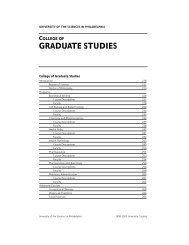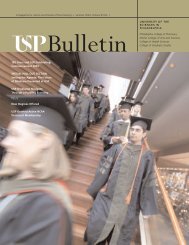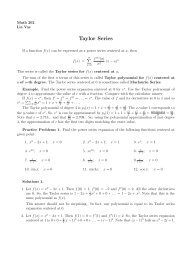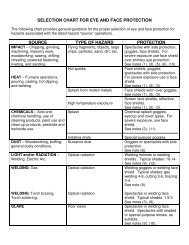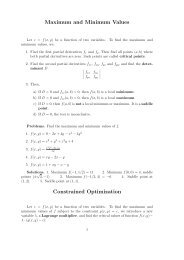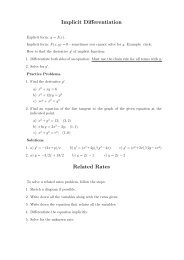Modeling with Exponential and Logarithmic Functions
Modeling with Exponential and Logarithmic Functions
Modeling with Exponential and Logarithmic Functions
Create successful ePaper yourself
Turn your PDF publications into a flip-book with our unique Google optimized e-Paper software.
MATH 101<br />
Lia Vas<br />
<strong>Modeling</strong> <strong>with</strong> <strong>Exponential</strong> <strong>and</strong> <strong>Logarithmic</strong><br />
<strong>Functions</strong><br />
Recall that a linear function has constant average rate of change: difference of two<br />
y-values for equally spaced x-values is constant.<br />
<strong>Exponential</strong> function has constant percent (relative) rate of change: quotient of two<br />
y-values for equally spaced x-values is constant.<br />
<strong>Exponential</strong> function:<br />
P = P 0 a t<br />
where P 0 is the initial quantity, t is independent variable (e.g. time), <strong>and</strong> a = 1 + r is the<br />
growth (a > 1) or decay (0 < a < 1) factor <strong>and</strong> r is the discrete (e.g. annual) percent<br />
rate of change. For example, this formula is used to model the population growth <strong>with</strong><br />
given annual percent rate given.<br />
If k is the continuous percent rate of change, then the function<br />
P = P 0 e kt<br />
models the change of desired quantity. Connection: if k = ln(1 + r) ≈ r if r is small.<br />
If k is positive it is called the growth factor. If k is negative, then the function is<br />
decreasing <strong>and</strong> k is called the decay factor. For example, this formula is used to model<br />
the decay of a radioactive substance.<br />
Problems:<br />
1. The time T in minutes for a small plane to climb to an altitude of h feet is given by<br />
T (h) = 50 log( 20000 ) where 20000 is the plane’s absolute ceiling. How long would<br />
20000−h<br />
it take the plane to climb to an altitude of 5000 feet Can the plane ever reach the<br />
absolute ceiling How high is the plane 50 minutes after the take of<br />
2. The amount of the drug (in milligrams) present in patients bloodstream t hours after<br />
it has been administered can be modeled by A(t) = 5.5e −.234t , How many milligrams<br />
are initially administered After how many hours will there be 1 mg of the drug in<br />
the bloodstream<br />
3. The pH of a liquid is defined as pH = − log[H + ], where [H + ] is the hydrogen ion<br />
concentration in moles per liter. Find the hydrogen ion concentration for a pH of<br />
5.2. If 9.98 · 10 −8 is the the hydrogen ion concentration for blood, find the pH.<br />
4. Suppose that the spread of a flu at a school <strong>with</strong> 2000 students total is given by<br />
2000<br />
f(t) = where t represent the number of days <strong>and</strong> f represents the number<br />
1+1999e −.8t<br />
of students infected. How many students are initially infected How many students<br />
are infected after a week After how many days will 45% of the total number of<br />
students be infected
5. A bacteria culture grows by the exponential model y = 200e kt . How many bacteria<br />
are there initially If the number of bacteria triples in 2 hours, find the number of<br />
bacteria after 5 hours.<br />
6. A bacteria culture starts <strong>with</strong> 600 bacteria <strong>and</strong> grows by the exponential model<br />
y = y 0 e kt . After 3 hours there are 2400 bacteria. Find the number of bacteria after<br />
4 hours. When will the number of bacteria be 5000<br />
7. Suppose that a population grows by 3% per year. Find the time it would take for<br />
the population to double.<br />
8. Suppose that a population grows by 5% per year. Find the time it would take for<br />
the population to triple.<br />
9. Happyville <strong>and</strong> Smileytown both have a population of 10,000 people presently. Happyville<br />
is increasing by 1500 people a year <strong>and</strong> Smileytown is increasing by 15% a<br />
year.<br />
a) Which town is growing faster<br />
b) Find formulas for the populations of these towns as function of time t in years.<br />
c) Use part b) to predict the size of both towns 5 years from now.<br />
d) Find a year in which population of Happyville will be over 25000. Do the same<br />
for Smileytown.<br />
10. The half-life of bismuth 210 is 5 days. How many days it will take the 1.5 grams of<br />
bismuth 210 to decay to 0.3 grams<br />
11. The biological half-life of triazolam, a drug used for treating insomnia, is 2.3 hours.<br />
What percent of an initial dose will remain after 5 hours<br />
12. The table below shows the number of rabbits in a local forest from 1982 to 1996.<br />
year 1982 1985 1988 1991 1994 1996<br />
number of rabbits 20 67 139 182 196 198<br />
Find a logistic model to fit this data. In what year were there 99 rabbits<br />
13. The table below shows the concentration of a drug in a patients bloodstream t hours<br />
after it was administered.<br />
time (hours) 0 1 2 3 4 5<br />
concentration (mg/cc) 2.5 2.29 2.1 1.95 1.81 1.7<br />
Find the exponential model that fit this data. When will the concentration drop<br />
bellow 1.2 mg/cc<br />
14. A new drug was put on the market in 1990. The table below shows the number of<br />
prescriptions written for this drug over a 10 year period.<br />
year 1990 1991 1992 1993 1994 1995 1996 1997 1998 1999<br />
numb. of prescr. 142 149 154 155 159 161 163 164 164 166<br />
Find a logarithmic model for this data. Using the model, how many prescriptions<br />
will be written in 2006 In what year will there be 178 prescriptions
15. The table below shows the yield (in mg) of a chemical reaction in the first 6 minutes.<br />
time (minutes) 1 2 3 4 5 6<br />
yield (mg) 1.2 6.9 9.3 12.7 14.1 15.7<br />
Use the scatterplot to find the best model to fit this data.<br />
determine in how many minutes will the yield be 20mg.<br />
Using that model,<br />
16. The table below shows the number of bacteria present in a culture t hours after the<br />
start of the experiment.<br />
time (hours) 0 1 2 3 4 5<br />
number of bacteria 250 342 521 736 1015 1483<br />
Use the scatterplot to find the best model to fit this data. According to that model,<br />
how many bacteria will be in the culture in 7 hours When will there be 5000<br />
bacteria<br />
Solutions:<br />
1. 6.25 minutes. No (zero in the denominator). 18000 feet.<br />
2. 5.5 milligrams. 7.3 hours<br />
3. 6.31 · 10 −6 moles per liter. pH is 7.4.<br />
4. Initially, 1 student; week later, 238; 9.25 days after, 45% of 2000 are infected.<br />
5. 200 bacteria. 3118 bacteria. 6. 3810 bacteria. 5000 bacteria in 4.6 hours.<br />
7. P = P 0 (1.03) t . t = 23.45 years. 8. P = P 0 (1.05) t . t = 22.52 years.<br />
9. a) Smileytown; b) y 1 = 10000+1500t, y 2 = 10000(1.15) t ; c) 17500 <strong>and</strong> 20114 people;<br />
d) t = 10 years <strong>and</strong> t = 6.556 ≈ 6.5 years.<br />
10. 11.6 days 11. 22.16% 12. In 1986.<br />
13. 9.36 hours (approximately 9 hours <strong>and</strong> 20 minutes)<br />
14. 172 prescriptions. In year 2021. 15. <strong>Logarithmic</strong> model. 10.34 min.<br />
16. <strong>Exponential</strong> model. 3025 bacteria. 8.4 hours (8 hours 24 minutes).






